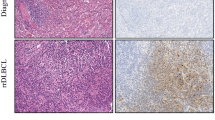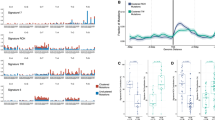Abstract
G proteins and their cognate G protein-coupled receptors (GPCRs) function as critical signal transduction molecules that regulate cell survival, proliferation, motility and differentiation. The aberrant expression and/or function of these molecules have been linked to the growth, progression and metastasis of various cancers. As such, the analysis of mutations in the genes encoding GPCRs, G proteins and their downstream targets provides important clues regarding how these signaling cascades contribute to malignancy. Recent genome-wide sequencing efforts have unveiled the presence of frequent mutations in GNA13, the gene encoding the G protein Gα13, in Burkitt’s lymphoma and diffuse large B-cell lymphoma (DLBCL). We found that mutations in the downstream target of Gα13, RhoA, are also present in Burkitt’s lymphoma and DLBCL. By multiple complementary approaches, we now show that that these cancer-specific GNA13 and RHOA mutations are inhibitory in nature, and that the expression of wild-type Gα13 in B-cell lymphoma cells with mutant GNA13 has limited impact in vitro but results in a remarkable growth inhibition in vivo. Thus, although Gα13 and RhoA activity has previously been linked to cellular transformation and metastatic potential of epithelial cancers, our findings support a tumor suppressive role for Gα13 and RhoA in Burkitt’s lymphoma and DLBCL.
This is a preview of subscription content, access via your institution
Access options
Subscribe to this journal
Receive 50 print issues and online access
$259.00 per year
only $5.18 per issue
Buy this article
- Purchase on Springer Link
- Instant access to full article PDF
Prices may be subject to local taxes which are calculated during checkout





Similar content being viewed by others
References
Dorsam RT, Gutkind JS . G-protein-coupled receptors and cancer. Nat Rev Cancer 2007; 7: 79–94.
Garcia-Marcos M, Ghosh P, Farquhar MG . GIV/Girdin transmits signals from multiple receptors by triggering trimeric G protein activation. J Biol Chem 2015; 290: 6697–6704.
O'Hayre M, Vazquez-Prado J, Kufareva I, Stawiski EW, Handel TM, Seshagiri S et al. The emerging mutational landscape of G proteins and G-protein-coupled receptors in cancer. Nat Rev Cancer 2013; 13: 412–424.
Feng X, Degese MS, Iglesias-Bartolome R, Vaque JP, Molinolo AA, Rodrigues M et al. Hippo-independent activation of YAP by the GNAQ uveal melanoma oncogene through a trio-regulated rho GTPase signaling circuitry. Cancer Cell 2014; 25: 831–845.
Van Raamsdonk CD, Bezrookove V, Green G, Bauer J, Gaugler L, O'Brien JM et al. Frequent somatic mutations of GNAQ in uveal melanoma and blue naevi. Nature 2009; 457: 599–602.
Van Raamsdonk CD, Griewank KG, Crosby MB, Garrido MC, Vemula S, Wiesner T et al. Mutations in GNA11 in uveal melanoma. N Engl J Med 2010; 363: 2191–2199.
Dhanasekaran N, Heasley LE, Johnson GL . G protein-coupled receptor systems involved in cell growth and oncogenesis. Endocr Rev 1995; 16: 259–270.
Kelly P, Moeller BJ, Juneja J, Booden MA, Der CJ, Daaka Y et al. The G12 family of heterotrimeric G proteins promotes breast cancer invasion and metastasis. Proc Natl Acad Sci USA 2006; 103: 8173–8178.
Kelly P, Stemmle LN, Madden JF, Fields TA, Daaka Y, Casey PJ . A role for the G12 family of heterotrimeric G proteins in prostate cancer invasion. J Biol Chem 2006; 281: 26483–26490.
Gutkind JS, Coso OA, Xu N G12 and G13 α subunits of heterotrimeric G proteins: a novel family of oncogenes In: SA M ed. G Proteins, Receptors, and Disease. Humana Press: Totowa, NJ, USA, 1998, pp 101–117.
Juneja J, Casey PJ . Role of G12 proteins in oncogenesis and metastasis. Br J Pharmacol 2009; 158: 32–40.
Xu N, Bradley L, Ambdukar I, Gutkind JS . A mutant alpha subunit of G12 potentiates the eicosanoid pathway and is highly oncogenic in NIH 3T3 cells. Proc Natl Acad Sci USA 1993; 90: 6741–6745.
Xu N, Voyno-Yasenetskaya T, Gutkind JS . Potent transforming activity of the G13 alpha subunit defines a novel family of oncogenes. Biochem Biophys Res Commun 1994; 201: 603–609.
Love C, Sun Z, Jima D, Li G, Zhang J, Miles R et al. The genetic landscape of mutations in Burkitt lymphoma. Nat Genet 2012; 44: 1321–1325.
Lohr JG, Stojanov P, Lawrence MS, Auclair D, Chapuy B, Sougnez C et al. Discovery and prioritization of somatic mutations in diffuse large B-cell lymphoma (DLBCL) by whole-exome sequencing. Proc Natl Acad Sci USA 2012; 109: 3879–3884.
Green JA, Suzuki K, Cho B, Willison LD, Palmer D, Allen CD et al. The sphingosine 1-phosphate receptor S1P(2) maintains the homeostasis of germinal center B cells and promotes niche confinement. Nat Immunol 2011; 12: 672–680.
Muppidi JR, Schmitz R, Green JA, Xiao W, Larsen AB, Braun SE et al. Loss of signalling via Galpha13 in germinal centre B-cell-derived lymphoma. Nature 2014; 516: 254–258.
Yoo HY, Sung MK, Lee SH, Kim S, Lee H, Park S et al. A recurrent inactivating mutation in RHOA GTPase in angioimmunoblastic T cell lymphoma. Nat Genet 2014; 46: 371–375.
Sakata-Yanagimoto M, Enami T, Yoshida K, Shiraishi Y, Ishii R, Miyake Y et al. Somatic RHOA mutation in angioimmunoblastic T cell lymphoma. Nat Genet 2014; 46: 171–175.
Cools J . RHOA mutations in peripheral T cell lymphoma. Nat Genet 2014; 46: 320–321.
Manso R, Sanchez-Beato M, Monsalvo S, Gomez S, Cereceda L, Llamas P et al. The RHOA G17V gene mutation occurs frequently in peripheral T-cell lymphoma and is associated with a characteristic molecular signature. Blood 2014; 123: 2893–2894.
Palomero T, Couronne L, Khiabanian H, Kim MY, Ambesi-Impiombato A, Perez-Garcia A et al. Recurrent mutations in epigenetic regulators, RHOA and FYN kinase in peripheral T cell lymphomas. Nat Genet 2014; 46: 166–170.
Fromm C, Coso OA, Montaner S, Xu N, Gutkind JS . The small GTP-binding protein Rho links G protein-coupled receptors and Galpha12 to the serum response element and to cellular transformation. Proc Natl Acad Sci USA 1997; 94: 10098–10103.
Hart MJ, Jiang X, Kozasa T, Roscoe W, Singer WD, Gilman AG et al. Direct stimulation of the guanine nucleotide exchange activity of p115 RhoGEF by Galpha13. Science 1998; 280: 2112–2114.
Kozasa T, Jiang X, Hart MJ, Sternweis PM, Singer WD, Gilman AG et al. p115 RhoGEF, a GTPase activating protein for Galpha12 and Galpha13. Science 1998; 280: 2109–2111.
Armbruster BN, Li X, Pausch MH, Herlitze S, Roth BL . Evolving the lock to fit the key to create a family of G protein-coupled receptors potently activated by an inert ligand. Proc Natl Acad Sci USA 2007; 104: 5163–5168.
Inoue A, Ishiguro J, Kitamura H, Arima N, Okutani M, Shuto A et al. TGFalpha shedding assay: an accurate and versatile method for detecting GPCR activation. Nat Methods 2012; 9: 1021–1029.
Jaffe ES, Pittaluga S . Aggressive B-cell lymphomas: a review of new and old entities in the WHO classification. Hematology 2011; 2011: 506–514.
Roschewski M, Staudt LM, Wilson WH . Diffuse large B-cell lymphoma-treatment approaches in the molecular era. Nat Rev Clin Oncol 2014; 11: 12–23.
Rasheed SA, Teo CR, Beillard EJ, Voorhoeve PM, Casey PJ . MicroRNA-182 and microRNA-200a control G-protein subunit alpha-13 (GNA13) expression and cell invasion synergistically in prostate cancer cells. J Biol Chem 2013; 288: 7986–7995.
Kelly P, Casey PJ, Meigs TE . Biologic functions of the G12 subfamily of heterotrimeric g proteins: growth, migration, and metastasis. Biochemistry 2007; 46: 6677–6687.
Yagi H, Tan W, Dillenburg-Pilla P, Armando S, Amornphimoltham P, Simaan M et al. A synthetic biology approach reveals a CXCR4-G13-Rho signaling axis driving transendothelial migration of metastatic breast cancer cells. Science Signal 2011; 4: ra60.
Cattoretti G, Mandelbaum J, Lee N, Chaves AH, Mahler AM, Chadburn A et al. Targeted disruption of the S1P2 sphingosine 1-phosphate receptor gene leads to diffuse large B-cell lymphoma formation. Cancer Res 2009; 69: 8686–8692.
Morin RD, Mendez-Lago M, Mungall AJ, Goya R, Mungall KL, Corbett RD et al. Frequent mutation of histone-modifying genes in non-Hodgkin lymphoma. Nature 2011; 476: 298–303.
Menon MP, Pittaluga S, Jaffe ES . The histological and biological spectrum of diffuse large B-cell lymphoma in the World Health Organization classification. Cancer J 2012; 18: 411–420.
Rohde M, Richter J, Schlesner M, Betts MJ, Claviez A, Bonn BR et al. Recurrent RHOA mutations in pediatric Burkitt lymphoma treated according to the NHL-BFM protocols. Genes Chromosomes Cancer 2014; 53: 911–916.
Fukuhara S, Chikumi H, Gutkind JS . RGS-containing RhoGEFs: the missing link between transforming G proteins and Rho? Oncogene 2001; 20: 1661–1668.
Mikelis CM, Palmby TR, Simaan M, Li W, Szabo R, Lyons R et al. PDZ-RhoGEF and LARG are essential for embryonic development and provide a link between thrombin and LPA receptors and Rho activation. J Biol Chem 2013; 288: 12232–12243.
Liu J, Lin A . Role of JNK activation in apoptosis: a double-edged sword. Cell Res 2005; 15: 36–42.
Bachman KE, Park BH . Duel nature of TGF-beta signaling: tumor suppressor vs. tumor promoter. Curr Opin Oncol 2005; 17: 49–54.
Qin L, Kufareva I, Holden LG, Wang C, Zheng Y, Zhao C et al. Structural biology. Crystal structure of the chemokine receptor CXCR4 in complex with a viral chemokine. Science 2015; 347: 1117–1122.
Kufareva I, Rueda M, Katritch V, Stevens RC, Abagyan R . Status of GPCR modeling and docking as reflected by community-wide GPCR Dock 2010 assessment. Structure 2011; 19: 1108–1126.
Mayr C, Bartel DP . Widespread shortening of 3'UTRs by alternative cleavage and polyadenylation activates oncogenes in cancer cells. Cell 2009; 138: 673–684.
Morgenstern JP, Land H . Advanced mammalian gene transfer: high titre retroviral vectors with multiple drug selection markers and a complementary helper-free packaging cell line. Nucleic Acids Res 1990; 18: 3587–3596.
Tokumaru S, Higashiyama S, Endo T, Nakagawa T, Miyagawa JI, Yamamori K et al. Ectodomain shedding of epidermal growth factor receptor ligands is required for keratinocyte migration in cutaneous wound healing. J Cell Biol 2000; 151: 209–220.
Wang Z, Martin D, Molinolo AA, Patel V, Iglesias-Bartolome R, Degese MS et al. mTOR co-targeting in cetuximab resistance in head and neck cancers harboring PIK3CA and RAS mutations. J Natl Cancer Inst 2014; 106: 1–11.
Inoue A, Arima N, Ishiguro J, Prestwich GD, Arai H, Aoki J . LPA-producing enzyme PA-PLA(1)alpha regulates hair follicle development by modulating EGFR signalling. EMBO J 2011; 30: 4248–4260.
Acknowledgements
This study was supported by the National Institute of Dental and Craniofacial Research intramural program at NIH. We thank Maria S Degese for her help with immunohistochemistry. AI was funded by PRESTO from JST. JA was funded by AMED-CREST from AMED. We thank Miho Morikawa for technical assistance with the TGFα shedding assay. RAD and MSL are supported by the Division of Intramural Research, NIAID, NIH. IK is supported by NIH grants R01 GM071872 and R01 AI118985.
Author information
Authors and Affiliations
Corresponding author
Ethics declarations
Competing interests
The authors declare no conflict of interest.
Additional information
Supplementary Information accompanies this paper on the Oncogene website
Supplementary information
Rights and permissions
About this article
Cite this article
O'Hayre, M., Inoue, A., Kufareva, I. et al. Inactivating mutations in GNA13 and RHOA in Burkitt’s lymphoma and diffuse large B-cell lymphoma: a tumor suppressor function for the Gα13/RhoA axis in B cells. Oncogene 35, 3771–3780 (2016). https://doi.org/10.1038/onc.2015.442
Received:
Revised:
Accepted:
Published:
Issue Date:
DOI: https://doi.org/10.1038/onc.2015.442
This article is cited by
-
Interaction kinetics between p115-RhoGEF and Gα13 are determined by unique molecular interactions affecting agonist sensitivity
Communications Biology (2022)
-
Clinical relevance of molecular characteristics in Burkitt lymphoma differs according to age
Nature Communications (2022)
-
GNA13 regulates BCL2 expression and the sensitivity of GCB-DLBCL cells to BCL2 inhibitors in a palmitoylation-dependent manner
Cell Death & Disease (2021)
-
Selective dysregulation of ROCK2 activity promotes aberrant transcriptional networks in ABC diffuse large B-cell lymphoma
Scientific Reports (2020)
-
Reduced RhoA expression enhances breast cancer metastasis with a concomitant increase in CCR5 and CXCR4 chemokines signaling
Scientific Reports (2019)



